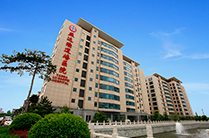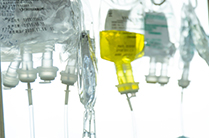Overview
Polycythemia Vera
Polycythemia vera is a rare blood disorder in which there is an increase in all blood cells, particularly red blood cells. The increase in blood cells makes the blood more viscous (thick), leading to strokes or tissue and organ damage.
Causes
Polycythemia Vera Causes
Polycythemia vera is one type of myeloproliferative neoplasmas (MPNs). Bone marrow contains stem cells that have the ability to mature into adult blood cells that enter the circulation, including red blood cells, white blood cells, and platelets. These stem cells are referred to as pluripotent hematopoietic precursor cells, or PHPC, due to their versatility. Each PHPC can reproduce itself (clone), in addition to producing daughter cells, called blasts.
In MPD, one abnormal PHPC clone has an ability to overgrow and self-renew more effectively then normal PHPC clones. In polycythemia vera, there may be an increase in just the red blood cells, both the red and white blood cells, or in the red and white blood cells and platelets.
The abnormal PHPC clone is the result of mutations to genes in these cells. These mutations are not inherited, but happen during a person's lifetime. Why this happens to a given individual is unknown in most cases.
Symptoms
Polycythemia Vera Symptoms
When there is an increased blood volume and viscosity (thickness), complications associated with this disease can occur. The following are the most common symptoms of polycythemia vera. However, each individual may experience symptoms differently. Symptoms may include:
• Fatigue and/or weakness
• Headache
• Dizziness
• Shortness of breath and difficulty breathing while lying down
• Visual disturbance, such as double vision, blurred vision, and blind spots
• Inability to concentrate
• Night sweats
• Flushed complexion
• Nosebleeds
• Bleeding gums
• Excessive menstrual bleeding
• Hemoptysis (coughing up blood)
• Bruising
• Itchy skin (particularly after a hot bath)
• Gout
• Numbness
• High blood pressure (hypertension)
Arterial or venous thrombosis, considered the most serious complications of polycythemia vera, can occur, resulting in a heart attack, stroke, or pulmonary embolism. Liver and spleen enlargement are other potential complications. The symptoms of polycythemia vera may resemble other blood disorders or medical problems. Always consult your doctor for a diagnosis.
Diagnosis
Polycythemia Vera Diagnosis
In addition to a complete medical history and physical examination, diagnostic procedures for polycythemia may include blood tests to observe the increased number of red blood cells in the body, and distinguish polycythemia vera from other conditions that could cause the red blood cell count to increase (such as certain cardiac and respiratory diseases, erythremia, and certain tumors).
Your health care provider may also perform blood tests to determine whether you have a genetic mutation in a gene called janus kinase 2, or JAK2.
Treatments
Polycythemia Vera Treatment
Specific treatment for polycythemia vera will be determined by your doctor based on:
• Your age, overall health, and medical history
• Extent of the disease
• Your tolerance for specific medications, procedures, or therapies
• Expectations for the course of the disease
• Your opinion or preference
Treatment may include:
• Phlebotomy
A procedure that involves removing blood from the body. Initially this must be done frequently, often every week, but once enough blood has been removed to deplete the body's iron stores, necessary to make blood quickly, it does not need to be done as often.
• Certain medications, including chemotherapy
Phlebotomy may not remove platelets effectively so medications are the treatment of choice if the platelets are dangerously high. The medicines help to keep your bone marrow from making too many blood cells, and keep your blood flow and blood thickness closer to normal.
• Radiation therapy
Radiation can help suppress overactive bone marrow cells. This therapy helps lower your red blood cell count and keeps your blood flow and blood thickness closer to normal.
(The content above extract from stanfordhealthcare.org)
-
-
Diseases ·
-














 京公网安备13108202000843号
京公网安备13108202000843号